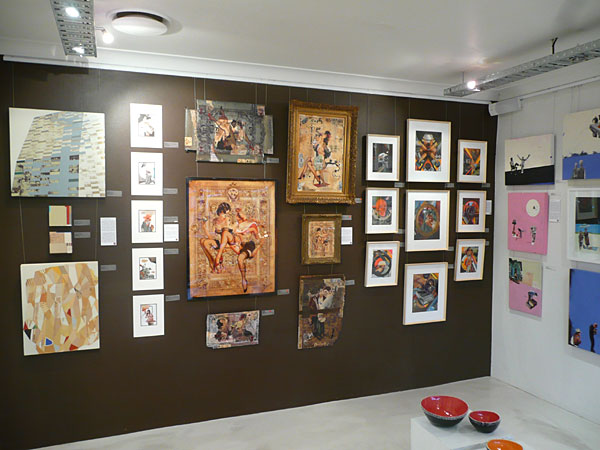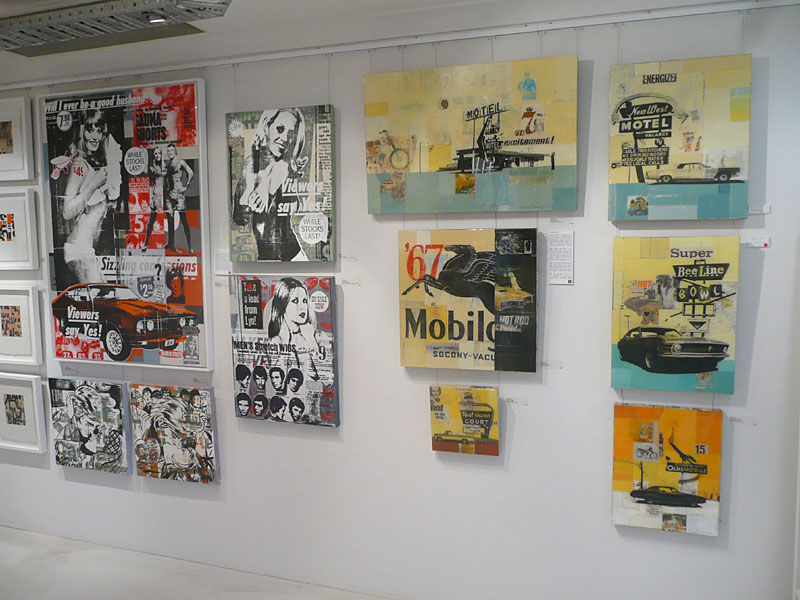Let’s dive in to Kareem Rizk’s stacks of torn leaflets, dated posters, old brochures and classic magazines, and rifle through his creative process that lends itself to handmade collages reminiscent of a simpler era. Dirty Laundry pulled back a few layers on this Australian native, to get to the bottom of his inspirations, aspirations and studio habits.
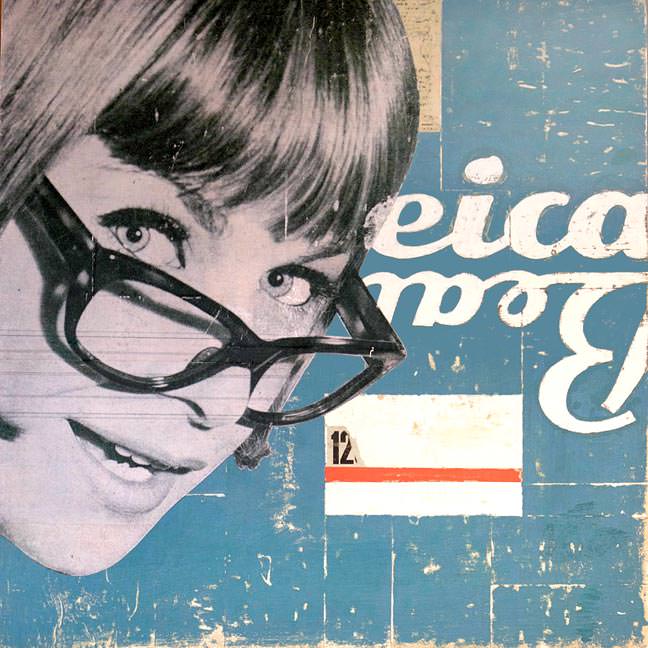

The Librarian
Mixed Media on Wood
20″ x 20″
2012
What draws you to collage art, and how long have you been at it? Do you remember your first piece?
I’ve been making collages and mixed media art consistently since 2006. But I started dabbling in it in early 2005 shortly after I graduated uni where I studied graphic design. During my course I was also encouraged to utilize many fine art and hands-on techniques and materials for assignments. Collage was one of them. After having been exposed to so many different fine art techniques and methods at uni, my interest in fine art continued to grow. I eventually shifted toward wanting to pursue a creative path that allowed me to be totally free creatively while using existing tactile materials that had texture, character or history.
I can’t remember specifically which was the very first piece I ever made but one of the first pieces I made was Powder Room. That piece stood out as being so different and so fresh from what I had previously been doing at my first graphic design job at a newspaper. That job was super corporate, so the practice of collage, the tactile, hands-on process became a creative outlet for me. It felt so organic – so different from the very strict, limited path I was ordered to have in editorial design.


Powder Room
Mixed Media
Do you prefer handmade or digital collages, and why? What are the advantages/disadvantages of working in each technique?
I’ve always preferred handmade and always will. There is a certain ephemeral and eclectic connection to the materials and images I use, but it’s also about the process of piecing together a collage or mixed media work. I’ve never experienced that connection on the same level when working in the digital process. However, the advantage of working in digital is that there are so many different directions a composition could head – especially with regards to layering and the ability to duplicate and modify all the elements on the screen. Transparency layer effects are also a big advantage because they add a different level of freedom and experience.
When making handmade works, a history of movements and placements becomes evident much like the history that is recorded while working in Photoshop. Except in the case of working with real tactile elements there is no undo function with handmade works. So fingerprints, glue stains and the detritus left behind from torn paper is often permanent. This is a very important characteristic in the handmade method and cannot be mimicked when working digitally.
I’ve always preferred handmade and always will. There is a certain ephemeral and eclectic connection to the materials and images I use, but it’s also about the process of piecing together a collage or mixed media work.
So take us through your process. How do you create these pieces, and what materials do you use?
Working Process
Most of the time I use good quality acid-free cartridge drawing paper for works on paper. Occasionally I’ve worked on old envelopes, mount board, notebook covers and colored craft paper. For bigger works I’ve mostly used stretched canvas. But in recent months I’ve been working more often on wood panels made of birch.
I often start off with an image that I feel is strong, dynamic, interesting or humorous and work around it. The majority of my works develop as I’m working on them. I very rarely know how a piece will look in the end until I feel that no more can be added or no more should be added. This is how I’ve been working since the beginning on all surfaces and in all mediums – paper, canvas, wood and digitally – utilizing my intuition. I was trained very well as a graphic designer but I’ve always felt that the art from of collage is not so much about trained technical skill, but very much about natural intuition.
Backgrounds are a key aspect in my work. The direction that a composition takes will often become apparent only after the background or foundation has been established. Differences in the tones and textures of the aged, discolored or handmade papers that have been glued down to construct a background can often determine how a piece will form.
Shapes and lines start to appear almost like a loose grid. The distribution of weight can also become apparent in particular areas on the working surface and so a piece can often be flipped sideways or upside down and a new direction for the piece will suddenly become apparent. In this way, the process becomes more spontaneous. There is a lot of peeling back, scratching, tearing and sanding that is involved in building up layers. Often there will be large areas that are worked over, covered up or scratched out.
Colored geometric shapes are often introduced to establish further dynamism and structure as well as introducing a point of hierarchy in relation to other elements on the working surface. This method is also applied in the form of acrylic paint, oil pastel and pencil in creating blocks and shapes of color.
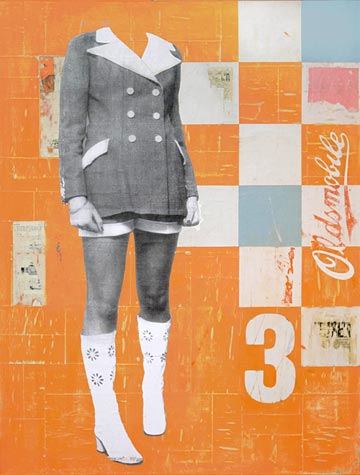

White Boots
Mixed Media on Canvas
36″ x 48″
2012
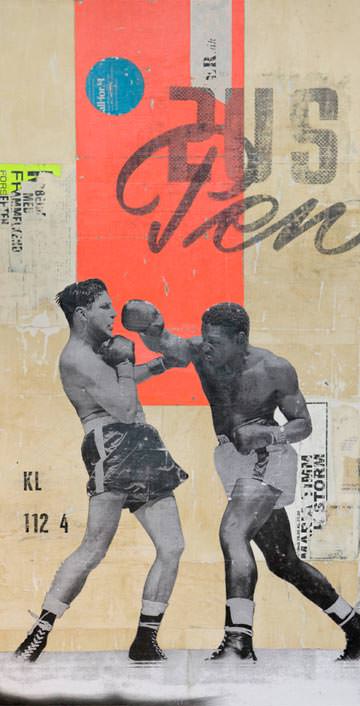

Boxer No.2
Mixed Media on Wood
18″ x 36″
2012
When it comes to the order of each step of the process it is not always predictable. Sometimes I find the main image before I start a piece and sometimes I will build up a background and some design elements on the working surface and then find an image that fits well with the background or developing composition.
On some occasions I have actually designed and decided in advance on finished compositions in Photoshop. I’ve then transposed that composition onto wood or canvas using fine art mediums to make original handmade artworks. This method has been very useful when making much bigger works, for example, canvases that are around 48 x 48 inches.
Materials
In addition to collage I use acrylic paint for creating areas of color, shape or line. I often use gel transfers for applying images, scratched logos, words or numbers. Otherwise I use good quality photocopies and seal all the finished layers with gel medium.
Most of my images come from old books and magazines that I’ve been collecting over the last few years. These usually range from the 1940s to the 1980s and I’ve collected magazines from all around the world. I usually find them at flea markets, thrift shops and yard sales but some I bought on eBay.
In between finding old magazines and books my eyes are often scanning city walls and streets for torn detritus, old bill posters, discarded tickets, luggage and airline tags, old brochures, bits of typography and whatever else I think might become useful one day for incorporating into my work.
I was trained very well as a graphic designer but I’ve always felt that the art from of collage is not so much about trained technical skill, but very much about natural intuition.
Do you keep the magazines whole? Or do you cut out the pieces that you like and store them for later?
I cut out the pieces I like. I’ve never been too cautious or delicate with the publications that I collect. I’ve always acquired them with the intention of using the original images and elements. I believe this has been vital to my development and work process. I store lots of images in labelled boxes or drawers. The magazines then get stored in stacks. I’ve also got packets of imagery that have different labels on them like transport, people, furniture, typography, design elements, animals, etc. I sort most of my imagery in this way. It makes it much easier to find specific images later on when I need them.
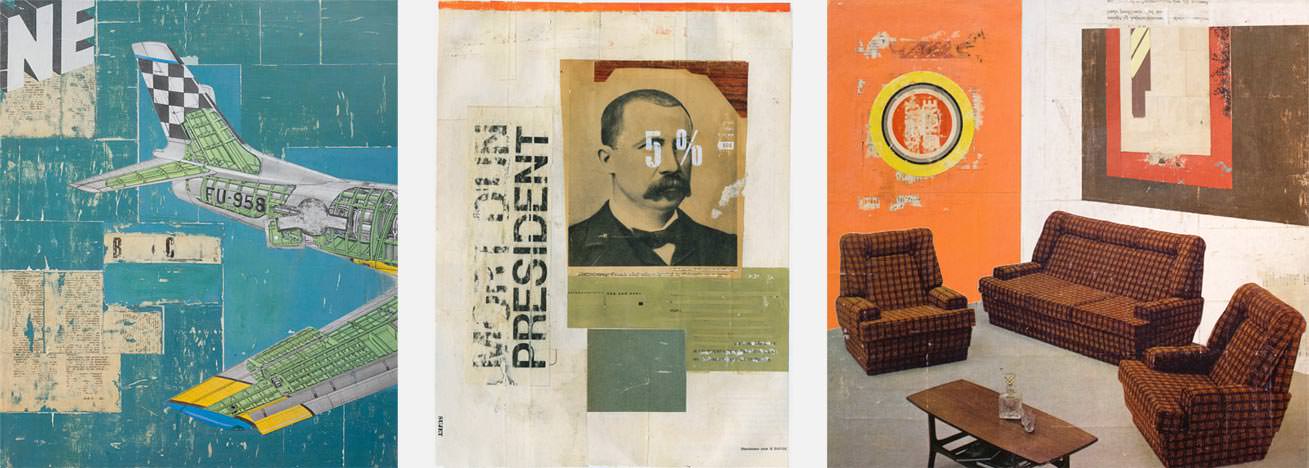

Tall Wing (No.3), Mixed Media on Wood, 20″ x 24″, 2012
Five Percent, Collage on Paper, 11″ x 14″, 2011
Lounge (No.2), Mixed Media on Wood, 20″ x 20″, 2012
Tell us about your fascination with the vintage/retro aesthetic. Is it developed out of a certain nostalgia, or are you purely attracted to it stylistically?
I’ve often felt that it’s not just the aesthetic that has attracted me. I feel that again part of my childhood has played a part in my affinity for nostalgic imagery and vintage subjects. Having lived in Egypt for four years of my childhood (1986-1990) I was surrounded by very old things that carried a lot of history and nostalgia. I was exposed to a culture early on that was almost a complete polarization of the culture I had experienced growing up in Australia.
I think being a child of the 80s has played a part as well. The music, the movies and many other 80s-era aspects have guided my interest in things that are aged, weathered, vintage or eclectic and have sometimes been associated with cult movements.
Tell us a bit about your studio practice?
First thing I do when I arrive at the studio is plug in my iPod and start playing some music. Or, as I’ve been doing more often in recent times, is play one of my favorite movies, which seems to blend into the background noise of me sawing, sanding, hammering and gluing my new works on wood panels. Lately, I’ve also been working on series or groups of works at one time. I often just sort through my drawers, packets and piles of categorized imagery and see what stands out to me at the time.
When I’m working on new stuff for a show I’m usually in the studio for eight-10 hours a day. In June and July 2012 I had big solo exhibition at the National Bank of Denmark. I had to produce 18 new pieces in three weeks. There were several, much larger works than usual so I was sometimes in there for up to 12 hours a day. But time flies when you love what you’re doing.
I feel that contemporary collage, as a standalone art form, hasn’t been fully recognized quite yet in the international contemporary art world, let alone in Australia. But it’s constantly growing and it will get there eventually.
So you started out in Melbourne, but recently moved to Copenhagen. What prompted the change in location?
The idea of travelling to a different country to make art and make new connections in a totally new culture was becoming more appealing to me. Europe especially was top of the list. I love travelling and seeing new places so it seemed like a logical move to make.
I also felt that there was greater potential for my work in Europe. I often felt that the art scene in Australia was quite limited, especially with regards to the kind of work that I produce. The street art and urban art scene in Australia is quite big, at least in comparison to other contemporary art genres. And I often felt that the street art scene overshadowed many other very contemporary art genres, especially collage. I feel that contemporary collage, as a standalone art form, hasn’t been fully recognized quite yet in the international contemporary art world, let alone in Australia. But it’s constantly growing and it will get there eventually. It’s just a matter of time. Now being surrounded by Europe, I’m enveloped in a plethora of new opportunities to continue developing.


Black Chair
Collage on Paper
11″ x 14″
2011
What’s one thing that you’ve learned or experienced that had a huge impact on you because of travelling?
The world is a lot smaller than some people think. All of us are so alike, no matter what culture or country you come from; no matter what your beliefs and no matter what language you speak. The further I’ve travelled and the more people I’ve met, the greater the sense of community I’ve felt.
Have you noticed that your work has transformed with your travels or your new location in any way?
It seemed that I was setting bigger challenges for myself during and after travelling. I grew in confidence and I was setting new goals for myself in how big my works could be and what kind of techniques and materials I could utilize. My work is still very simple in composition but I’ve been aware that it has also become a lot more refined, especially my works on paper. Maybe it’s a result of a new influx of inspiration from graphic design. But maybe it’s also a natural gravitation toward further shaping and solidifying my style.
But I also feel that my knowledge of who I am as a person had certainly become much more expanded and refined as a result of travelling so broadly. So I’ve often felt that this has been directly reflected in many ways in the work I’ve produced over the last couple of years. I do believe that when I made the choice to expand my horizons by travelling and creating new opportunities, it also dissolved some of the boundaries I seemed to be faced with in developing as an artist.
In what ways did you go outside your comfort zone?
One of the pivotal things I did was quit my first and only graphic design job at Melbourne’s biggest newspaper. I had a very good salary as a junior designer, I was driving a Lexus, planning holidays to Hawaii and tropical north Queensland and I had a pile of money in the bank. But I gave it all up because I was just not inspired. The work I was doing was not satisfying my need to be creative. But I had noticed as well that I was also becoming a bit disenchanted by the industry that I was working in. Thinking about it, I don’t think commercial graphic design was ever my real calling. Most of my friends at the time thought this was a crazy move, but it freed me in ways I couldn’t have imagined. It’s one of the best decisions I’ve ever made.
I also travelled. I went backpacking for several months throughout Canada, the U.S., Mexico and all over Europe. I saw and experienced so many extraordinary things and met so many amazing people. I certainly couldn’t have done that while tied to a desk in an office, chasing a higher job position simply to justify my education. I couldn’t have done that by staying “safe.”
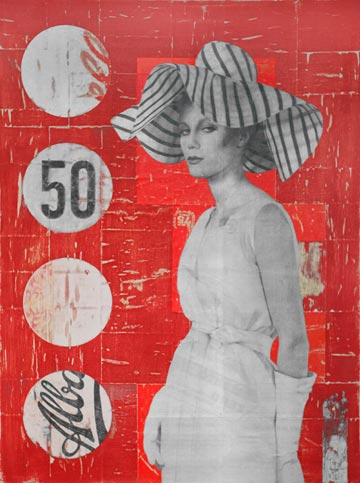

Fashion (No.5)
Mixed Media on Canvas
30″ x 40″
2012
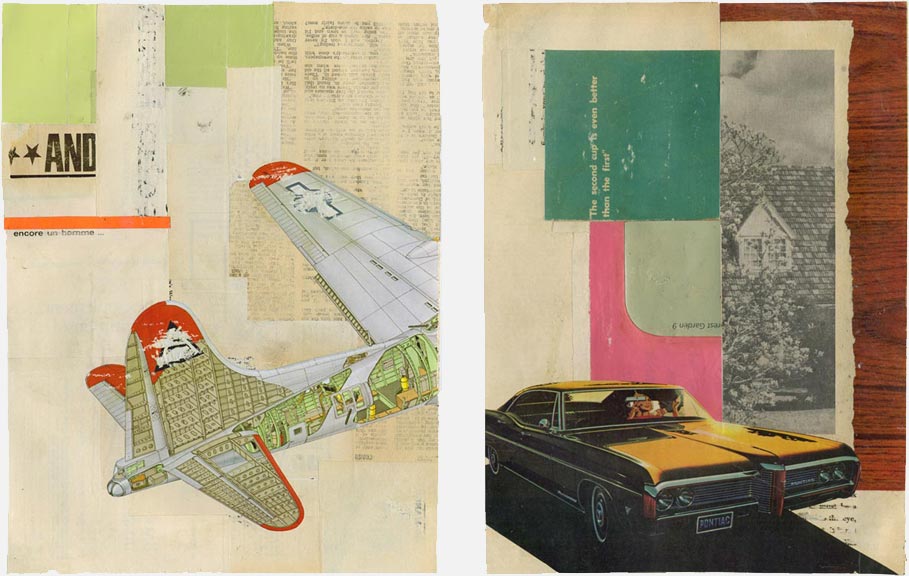

Model Aeroplane (No.4), Collage on Paper, 11″ x 14″, 2011
Pleasantville, Collage on Paper
Tell us about some of your favorite projects.
In 2008 I was asked by Art Whino Gallery in DC and the shoe brand, Tagur, to create a pair of custom sneakers plus an original artwork that was themed in relation to the shoes. Tagur sent a pair of blank sneakers out to all the participating artists and each artist just let loose. The sneakers and art that returned to the gallery was amazing.
My work also received such a great response that Tagur approached me to put my shoe design into production as a limited edition series of sneakers. It was such fun work to produce because it was such a different surface to work on (e.g. shape, material etc.). It was fun to research what kind of inks, dyes, acrylics and adhesives could go onto different parts the shoes and laces. I had to reframe the way I thought about the mediums and the application. In many ways it also seemed more like a graphic design project and I hadn’t experienced that kind of freedom or variety in graphic design since I’d graduated university.
Another very fun project was a group show that I curated at Retrospect Galleries in Byron Bay, Australia titled Retroism in 2010. I was given free reign to select up to 14 artists who work predominantly with collage and mixed mediums and whose work has strongly influenced a resurgence of vintage and nostalgic imagery that has been prevalent in design and illustration over the last few years. With the exception of a couple of artists who unfortunately couldn’t be involved, it was a dream team of international artists to be able to exhibit with. They are also a group of artists who I’ve been associated with in one form or another over the last few years. There was quite a bit of local press on the show and I was interviewed on a local Byron Bay chat radio show along with the gallery director. It was a good introduction to some different forms of media promotion that I hadn’t previously been exposed to.
I had to reframe the way I thought about the mediums and the application.
What other artists do you associate with, and who are the artists who have made the biggest impression on you?
The artist that made the biggest impression on me in the beginning was Eduardo Recife. I contacted him one day back in 2006 to say how much I enjoyed his work and to introduce him to my own work. Since then we’ve written emails to each other as often as possible to stay in touch. In 2008 we also made a collaborative artwork together – a very detailed digital collage.
As a result of my fairly extensive travels and networking within the collage and mixed media art community over the last few years, I’ve also either collaborated, traded, been influenced by, exhibited, been interviewed by, worked with, done business together, had a dialog, had dinner or drank beers with: Robert Mars, Mario Wagner, Charles Wilkin, Cecil Touchon, Paul Burgess, Hanneke Treffers (aka Handiedan), Julien Pacaud, Greg Lamarche, Randel Plowman, Nick Morris, James Gallagher, Rick Reese, Brandon McLean, Sean Hillen, Liz Cohn, Fred Free, Seniorita Polyester and Eva Han – just to name a few.
Some of my very first 20th century inspirations for wanting to make art in general were Kurt Schwitters, Richard Hamilton, the Dada movement, David Hockney, Magritte, Jasper Johns, Ed Ruscha and Jackson Pollock.


Say Hello to the Neighbours (No.2)
Mixed Media on Canvas
30″ x 40″
2011
Who’s art do you own?
I own original artworks by: Robert Mars, Brandon McLean, Eva Han, Rick Reese, Oscar Gaynor, Liz Cohn, and Senorita Polyester. I also have prints of works by Eduardo Recife and Andy Burgess.
Outside of creating art, what other activities do you enjoy?
I love cooking and complimenting it with good wine (mostly international food – Indian, Middle Eastern, Thai, Mexican etc.). I love movies, particularly from the 80s and 90s and documentaries about space, wildlife and nature. I love listening to music. Recently I’ve been listening to a lot of old jazz, R&B, soul and funk, some folk (Rodriguez), 60s/70s/80s rock, 80s pop and reggae. I like riding my bike around Copenhagen, hanging out with friends at the park and going to the music and culture festivals in the city, drinking Danish beer and, of course, travelling.
I’ve recently been restoring some old furniture and making some new furniture for the new apartment that my wife and I recently moved in to. It’s not something I’ve done a whole lot of but it’s fun and I can see myself doing more of it because I love working with wood and paint.


Impala
Mixed Media on Wood
24″ x 30″
2012
If your house were on fire and you could only save five things, what would you take?
My wife! (if she were in the house).
The big cupboard that currently contains my private art collection.
My box of photos, letters, postcards, and knick-knacks from family, friends and loved ones.
My external hard drive (which has about 500GB of my life on it).
The big, big box that holds much of my old magazine collection.
And finally, tell us something not many people know about you.
It’s not directly related to me personally but I always enjoy telling the story of my Australian great-, great-grandfather, John Deason and his friend Richard Oates, who found the biggest gold nugget in the world on Feb. 5, 1869 in Victoria, Australia. The nugget was called “The Welcome Stranger,” which is actually what I’ve been called on a few occasions by my Danish parents-in-law since moving to Copenhagen.
More of the story can be found here.


Impala (No.2), Collage on Paper, 10.5″ x 11.5″, 2011
Ali (No.2), Mixed Media on Canvas, 30″ x 30″, 2012
Motorbike, Mixed Media on Wood, 20″ x 24″, 2012
